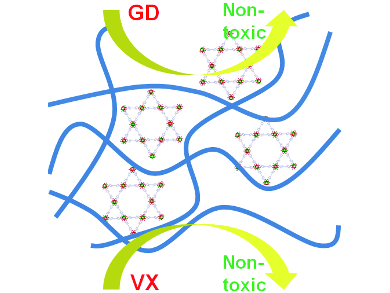Organophosphates such as pesticides (parathion and paraoxon) and nerve agents (O-pinacolyl methylphosphonofluoridate, GD, and O-ethyl S-(2-(diisopropylamino)-ethyl)methylphosphonothioate, VX) can be extremely toxic. These organophosphate nerve agents bind irreversibly to the enzyme acetylcholinesterase (AChE), preventing the breakdown of acetylcholine, which leads to sustained muscle contraction, and eventually oxygen deprivation and death. Though some organophosphates can be decomposed by hydrolysis in water, reaction rates in the absence of catalysts are typically too slow to be effective.
Omar K. Farha, Joseph T. Hupp, Northwestern University, Evanston, IL, USA, and colleagues have previously developed a metal-organic framework (MOF) containing Zr6 clusters for the hydrolysis of nerve agents in N-ethylmorpholine buffer solution [1]. The need for a buffer solution makes it difficult to use these catalysts in applications such as masks and protective suits, so, to overcome the limitations associated with the use of a homogeneous buffer, they sought to heterogenize the buffer using a basic polymer, polyethyleneimine (PEI).
In this work, they demonstrate the hydrolysis of a nerve agent simulant (dimethyl 4-nitrophenylphosphate, DMNP) and nerve agents GD and VX with a MOF catalyst/heterogeneous buffer mixture. The hydrolysis of the simulant and nerve agents in the presence of the heterogeneous buffer was fast and effective. Importantly, this heterogeneous mixture can also be prepared as a composite with a cellulose fiber that is still effective at detoxifying the simulant, making it more useful for practical applications.
- Detoxification of Chemical Warfare Agents Using a Zr6-Based Metal-Organic Framework/Polymer Mixture,
Su-Young Moon, Emmanuel Proussaloglou, Gregory W. Peterson, Jared B. DeCoste, Morgan G. Hall, Ashlee J. Howarth, Joseph T. Hupp, Omar K. Farha,
Chem. Europ. J. 2016.
DOI: 10.1002/chem.201603976
[1] M. J. Katz, J. E. Mondloch, R. K. Totten, J. K. Park, S. T. Nguyen, O. K. Farha, J. T. Hupp, Simple and Compelling Biomimetic Metal–Organic Framework Catalyst for the Degradation of Nerve Agent Simulants, Angew. Chem. Int. Ed. 2014, 53, 497–501. DOI: 10.1002/anie.201307520




